Warwick School
 | |
| Motto |
Altiora Peto (Latin for "I seek higher things") |
|---|---|
| Established | 914 |
| Type |
Public school Independent day and boarding school |
| Religion | Church of England |
| Head Master |
D. A. Smith, MA; PhD (Senior School), A. Hymer, MAEd (Junior School) |
| Deputy Headmaster |
J. S. Barker, BA (Senior School), T. Wurr (Junior School) |
| Chairman of Governors | A. C. Firth |
| Location |
Warwick Warwickshire CV34 6PP England 52°16′41″N 1°34′26″W / 52.278°N 1.574°WCoordinates: 52°16′41″N 1°34′26″W / 52.278°N 1.574°W |
| DfE URN | 125781 Tables |
| Staff | ca.130 |
| Students | 1245 |
| Gender | Boys |
| Ages | 7–18 |
| Colours |
Blue and White |
| Former pupils | Old Warwickians |
| Website | www.warwickschool.org |
Warwick School is an independent school with boarding facilities (also known as a public school) for boys in Warwick, England. It is the fifth-oldest surviving school in England after King's School, Canterbury, King's School, Rochester, St Peter's School, York and Wells Cathedral School. It is the oldest boys-only school in the United Kingdom. It was active in the reign of King Edward the Confessor (reigned 1042–1066) and it is speculated that it existed before this date. Its headmasters have been members of the Headmaster and Headmistresses Conference since 1896.
Enrolment

Entrance to Warwick School is competitive, with entry points at 11+, 12+, 13+ and Sixth Form. Starting in the academic year 2017-18 were 990 boys in the senior school, aged from 11 to 18, and 256, aged from 7 to 11, in the junior school. It forms part of the Warwick Independent Schools Foundation which includes Warwick School (senior & junior), King's High School and Warwick Preparatory School.
There are four main points of entry for pupils:
For the Junior School, at age 7,judged by a combination of internal exam and interview.
For the Senior School, at age 11, judged by an internal exam for all students, with an internal set of exams for scholarship entry; as well as interview (with further separate interviews for scholarship candidates).
For the 13+ Entrance, judges by common entrance papers as well as internal exams and interviews.
For the Upper School, at age 16, judged by subject-specific exams and interviews and conditional upon GCSE results. Only a handful of places are available here and a further two scholarships are awarded.
Houses

Boys in the senior school are put into one of seven houses which compete against each other in sports and other activities, such as debating. The house system is now combined with the system of forms. Six of the houses are named after people connected with the history of the town of Warwick (Tudor, Guy, Greville, Brooke, Oken and Leycester). School House, formerly for boarders only, is now open to day-boys as well. The Junior School has four houses named after more general historical figures (Drake, Scott, Wellington and Nelson).
Traditions
Visit of the Town Crier
One of the greatest traditions in school, and one that has been present for well over a century, is that of the Town Crier of Warwick’s visit to the school to announce the added week of holiday for the Michaelmas half term. The routine involves a speech, read from a magnificent parchment, to the whole school in the chapel quad, followed by a mock discussion with the headmaster, and ending with a declaration about the holiday, to cheers from the boys.
The School Crest
It was the headmaster from 1885 – 1896, Rev John Pearce Way, who not only commissioned the first written history of the school, but who also attempted to change its name from The King’s School, Warwick to Warwick School, to introduce a school song, a school motto and also a school coat of arms. Changing the name was blatantly illegal (although he probably didn’t realise it at the time) and this actually took decades to accomplish. He had more success with the school motto, Altiora Peto, introduced in 1893. It means “I seek higher things”. His attempt to draw up a school coat of arms was not a success, and neither was that of one of his successors, Horace Seymour Pyne (headmaster from 1906 – 1928), who went as far as to include his own version – also illegal – in the stained glass window of the chapel, where it can be seen to this day.
The use of the Portcullis in school badges (and in the name of the school magazine) derives from its use by King Henry VIII, who re-founded the school in 1545. The Tudor Rose was also, therefore, used at times as a school emblem in the Victorian era.
It fell to George Riding (headmaster from 1928 – 1933) to go through the proper channels and arrange for a coat of arms, which he designed, to be awarded to Warwick School in 1931. It is officially:
Gules a Cross Flory in the first quarter a Fleur-de-lys Or on a chief of the second three Martlets Azure. Crest: On a wreath of the colours Upon a Portcullis Chained Or a Bear erect Argent Muzzled Gules supporting a Ragged Staff also Argent.
The three martlets are heraldic swallows, depicted without feet because of a mediaeval belief that they could not perch on the ground. Like the large golden cross, they are emblems used by King Edward the Confessor, reputed to be one of the original founders of the school. The fleur-de-lys and portcullis are emblems of King Henry VIII, and the Bear and Ragged Staff have been the crest of the family of the Earls of Warwick since at least the 14th century. It is notable that only with the arms of Warwick School and the Earl of Warwick is the bear allowed to be depicted without a chain. The County of Warwickshire uses the Bear and Ragged Staff in its coat of arms, also awarded in 1931, but the bear is chained.
Uniform
Regular Uniform
Previously the uniform at Warwick has been rather non-standard, but at one time it included the unpopular and uncomfortable Eton collar for boys below a certain height (5'6", or 1.68m). This arbitrary cut-off point meant, in fact, that most boys in the 1920s had to wear this collar. The current school uniform, which has been in use since the 1930s, along with the present school crest, is a navy blue blazer, worn with a white shirt (or grey in junior school), black or charcoal trousers (with shorts for Junior School), and a tie. Pupils may wear a black or dark blue V-neck jumper over their shirt should they wish to do so. Sixth form dress is a dark grey or navy suit, with the sixth form tie (unless another variant has been achieved).
Ties and awards
Special ties are awarded to pupils for achievement in different areas, and can be worn in place of their regular school tie:
·Prefect tie - Red and Grey striped
·Full Colours (for sport, drama and music) - Silver/White and Blue striped
·Half Colours (for sport, drama and music) - Blue and Silver/White striped (Colours inverted to that on full Colours)
Boarders also have a system for recognition of officials in their houses, being:
·Head of boarding house - Gold Badge
·Boarding prefects - Silver Badges
Finally, house captains who were formerly presented with a badge, are now bestowed with the prefect tie, with the roles of Vice-Captain and Captains of individual sports now being honorary.
History
Early Beginnings and The Move to St Mary's
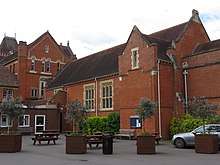
The first time that the town of Warwick was ever recorded was in the 9th and 10th century Anglo-Saxon Chronicle in 914 during the rule of Ethlfleda, daughter of Alfred the Great. This, the oldest surviving boys' grammar school in the world, was active in the time of King Edward the Confessor (reigned 1042–1066) and probably for a century earlier, most likely in the grounds of Warwick Castle. By 1477 lessons were held in the old church of St John the Baptist in the Market Place, and the school was still there when King Henry VIII re-founded it as "The King's New Scole of Warwyke" in 1545. At this point the new grammar school moved to what is now the Lord Leycester Hospital, and later on to St Peter's Chapel over the Eastgate, now part of King's High School. It is not clear where the school was in the 17th century, but it had a couple of notable schoolmasters in the form of the epigrammatist John Owen (1595–1622) and Rev Thomas DuGard (1633–49), later Rector of Barford Church, who did so much to record the history and daily life of the school in his Latin diary - which remains untranslated. The grammar school moved to the disused medieval buildings of the Vicars Choral in St Mary's churchyard around 1697, and stayed there for the next 200 years. Despite initially thriving, with up to 60 boarders, by the end of the 18th century "there were no boarders and very few, if any, free scholars". In 1792 there began the 50-year tenure of Rev George Innes as Master, and the school's fortunes once again fluctuated wildly. Educational reforms and the shake-up of local charities dramatically improved the school under Rev Herbert Hill (1842–76), and a modern curriculum was introduced. It was only in 1871, though, that a list of the 50 or so pupils attending the school began to be kept. Three new schools were proposed in the 1870s, and had all begun operations by 1879. They were; The King's Grammar School, on a new site south of the River Avon, with a classical curriculum, The King's Middle School in The Butts, providing a "commercial education" for "less academic" boys and King's High School, in Landor House, Smith Street.
Crisis
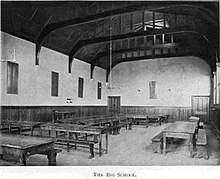
The late Victorian era was initially one of success and growth. A Junior Department (now the Junior School) was opened in 1889, and even a chemistry laboratory was constructed. The number of pupils reached 135 (with six staff) in 1885, and 168 ten years later. Also at this time a Cadet Corps was established, The Portcullis started to be published, school Rules were drawn up, Oxford Scholarships started to be won, the name Warwick School was unofficially introduced, with the motto Altiora Peto, an English school song, Here's a Song For All, was written, with music by John Farmer and The Limes were planted.
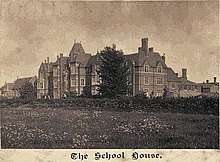
The years 1896 to 1906 were ones of increasing crisis for the school, however, culminating in its economic collapse and temporary closure, the flight of the headmaster, the sacking of all the staff, the withdrawal of most of the boys and a merger with the King's Middle School in 1906. However, there were some positive achievements during this troubled decade. A new wing was added at right angles to the chapel, the Old Warwickian Association was founded, the House system was started, the chapel was completed (apart from the gallery), the dining room gained its wooden panels, a Science Block (now the music department) was built, the first history of the school was published (A. F. Leach), and a Latin school song, Floreat Domus, was composed for the 1906 Warwick Pageant.
Early Twentieth Century Growth
Under physicist H. S. Pyne (1906–28) the school rapidly grew in numbers. By the late 1920s, there were almost 400 boys in the school, including 146 (very profitable) boarders, almost double the permitted number. The staff grew to 25 at this time.
By 1920 the engineering shop was built, the outdoor swimming pool was opened, electric lighting (instead of gas) was installed throughout the school, a school orchestra was created, a yearly carol service was held in St Mary's church, the Town Crier visited yearly, the annual Science Exhibition was started, joint debates with King's High School were held, eight free places were offered to local elementary school pupils and many new buildings were erected.
The First World War had a shattering effect on the school and its headmaster, whose son Eric was killed, along with 87 other OWs and two former staff. Pyne generously paid for the chapel gallery and west window as a war memorial, but overall the school was getting somewhat run down by the late 1920s despite a new stage being constructed in Big School. The incoming headmaster in 1928, the linguist G. A. Riding from Rugby School, saw himself as a "new broom sweeping clean", and his controversial reign was blighted in particular by two arson attacks in 1930. However, there were many achievements during this era. The design of the present school badge and uniform was created, the first overseas school trips took place and form orders were introduced (with the bottom boy being flogged in front of the whole school).
Politics, music and drama flourished as never before (as did boxing as a school sport) in the mid-1930s under headmaster Eric Percival Smith (1933–36), and the most popular society in the school was The League of Nations Union.
War and Independence
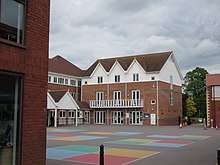
The long headmastership of the Cornish chemist A. H. B. Bishop (1936–62) started badly when he decided to re-open the Junior House, closed in 1935 by agreement with a local preparatory school, as a private junior school in 1938. This led to his temporary suspension from the Headmasters' Conference and a vigorous campaign, which included writing to the most famous OWs of the time, including the Poet Laureate John Masefield, in order to get himself reinstated. Masefield's non-committal reply is displayed in the school museum. Bishop encountered further legal problems when he was sued for damages in 1941 at Birmingham Assizes. A 14-year-old boarder doing unsupervised war-time agricultural work in the summer of 1940 at Charlecote lost an eye as a result of a clod of earth being thrown at him. Bishop initially lost the case, and the boy won £750 damages, but the verdict was reversed on appeal, the boy ending up with nothing, on the grounds that the court thought that supervision had not been necessary.
As in the conflict of 1914-18, the number of pupils in the school actually grew during the Second World War, the total rising to 450 by 1946. It was difficult to appoint and retain adequate staff, and the school was forced to share its premises with an evacuated Birmingham School between 1939 and 1940. Air-raid shelters were dug, gas-masks were assembled, and war-time losses of Old Warwickians were almost as serious as they had been 25 years earlier. The most fundamental change at this time, however, occurred as a result of the 1944 Butler Education Act, one aim of which was to make secondary education free of charge for all pupils. At Warwick the fees had to more than triple (to £16 per term for day-boys) as the substantial Local Education Authority subsidy to the school was going to come to an end. However, the very same LEA would still provide total funding for 45 "free place" boys in every year, and also institute a fees remission scheme for parents earning less than £7 10s per week. In 1946 the governors were forced to declare that Warwick School would have to become independent.
Post War Stability and Growth
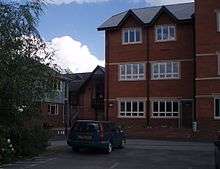
By the time A. H. B. Bishop retired in 1962, there were 742 pupils and 44 staff in the senior and junior schools. During the late 1940s and 1950s a new building called The Orlits was built, a new biology laboratory and Memorial Gymnasium were constructed, School Certificate examinations became "O" and "A" levels, and new chemistry and physics laboratories were built, leaving Keeling's original science block to be taken over by the geography and history departments.
There was a highly successful visit by the Queen Mother in 1958, as well as earlier visits by Viscount Montgomery of Alamein and Sir Anthony Eden (Prime Minister 1955-7).
From 1962 to 1977, headmaster and historian P. W. Martin continued to modernise the school. Parents' evenings were introduced, Friends of Warwick School and the Community Service Organisation were set up, the compulsory wearing of the school cap was abolished, a language laboratory was created, the school's first computer was built, the School Mathematics Project, the Cambridge Classics Project and Nuffield Science were introduced, the Guy Nelson Hall was constructed, the English and mathematics departments got new teaching blocks, the old Big School was converted into the school library, Bridge House and its land were purchased, the temporary New Buildings were finally demolished after 55 years of use, and the school bought its first blue-and-white minibus.
Late 20th century
Craft, Design and Technology became an academic subject, and the school's first dedicated computer room opened in 1981 with half a dozen Commodore PETs, soon to be replaced in 1986 by a full-size room with 17 BBC micros.
Physicist Dr P. J. Cheshire (headmaster 1988-2002) saw to it that the facilities of virtually every department in the school were improved. In particular, the 1949 Orlits building was replaced by a purpose-built geography and history block, the music department moved into Keeling's gutted 1905 science laboratories, the 1911 outdoor swimming pool was filled in and replaced by a new Sports Hall, the 1890 gymnasium was converted into a Sixth Form Centre, the library and IT departments moved to a new building named after alumnus John Masefield, the old library became an extension dining room and functions area (the Pyne Room), and a drama studio was built at the back of the Guy Nelson Hall.
A brand new theatre was built on the site of, and named after, Bridge House, and all staff were issued with laptop computers. An AstroTurf games pitch was built, the entire Junior School was refurbished and extended into a quadrangle, and the school's first Archivist, Gervald Frykman, was appointed.
The Twenty First Century
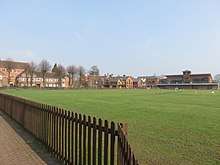
A second history of the school was published (G. N. Frykman and E. J. Hadley) in 2004, the school co-founded the Independent-State School Partnership scheme, sixth-form girls from King's High School joined the Combined Cadet Force and some joint teaching started, a new maintenance department was built behind the Bridge House Theatre, a new science block (the Cheshire Building) was built on the site of the 1879 sanatorium, the 1957 science block was demolished and replaced with the Thornton Building, originally containing the mathematics, classics and religion and philosophy departments (English moved in instead of religion and philosophy, and classics, in 2016), floodlit games pitches became available, the 1st XV won the Daily Mail Cup in 2007, and national recognition was won by the school's concert band and drama students. All teaching in the original 1879 classrooms finished and a museum and functions room was opened, and named the Portcullis Room.
Two histories of the school have been published. The first appeared in 1906 at the exact time that the existence of the original Grammar School was under threat, as unpublished accounts in the school archives show. The second was published in 2004; of the two co-authors, Gervald Frykman is the school's first Archivist, and used much recently discovered material to bring the school's varied fortunes before World War II to life; while Eric Hadley, the editor of the school's yearly chronicle The Portcullis, portrays the school's continued rise in numbers, and its successes, since then. A second edition of Frykman and Hadley was published in 2014, in response to the assumed 1,100th anniversary of the foundation of the school.
Next door to the main school is the Junior School, opened in 1889. Although it closed and re-opened several times in the first half of the twentieth century, it has been fully operational since 1938, and now caters for 256 boys from 7 to 11 years of age, the majority of whom then pass into the senior school.
Modern buildings

Although its 1879 buildings are still in use, there have been many additions since then. All teaching now takes place in specialised departmental areas elsewhere.
A new Science Centre, designed by Brown Matthews Architects Ltd., opened for use in June 2007. It houses biology, physics and chemistry laboratories. It was built on the site of the original 1879 sanatorium.

The former main hall of the school, the Guy Nelson Hall, was built, following an appeal, between 1969 and 1970. It had seating for about 600 people, which was far less than the total size of the school in the 2000s and 2010s. Alderman Guy Nelson, after whom the hall is named, was a long-serving Chairman of Governors (1938–1963). The hall was demolished in 2015 and was replaced by a much larger one, named Warwick Hall, which was opened in September 2016 by Michael Attenborough CBE.
The school has its own theatre, the Bridge House Theatre, holding around 310 people. It was opened on 1 May 2000 by Dame Judi Dench and was designed by Michael Reardon Associates. It was intended from the start to be used both by the school and by local organisations in the town, and has its own website: https://www.bridgehousetheatre.co.uk/. The theatre is set out, as many larger theatres are, with both stall and circle seating and space for a small orchestra pit if needed.
In March 2013, the revamped and modernised Sports Pavilion, renamed the Halse Sports Pavilion after former headmaster Edward B. Halse (2002-2013), was opened in a ceremony led by British politician and former track and field athlete, Lord Coe.[1] On 2 June 2014, as the climax of the Jubilee Year, HRH Charles, Prince of Wales visited Warwick School as part of his visit to Warwick and Stratford, unveiling a commemorative plaque.[2]
Headmasters
- 1792-1842 Rev George Innes
- 1843-1876 Rev Herbert Hill
- 1876-1880 Rev William Fisher MacMichael
- 1881-1885 Rev William Grundy
- 1885 Rev Philip Raynor (interregnum)
- 1885-1896 Rev John Pearce Way DD
- 1896-1902 Rev Robert Percival Brown
- 1903-1906 Rev William Theodore Keeling
- 1906-1928 Horace Seymour Pyne
- 1928-1933 George A Riding
- 1933-1936 Eric Percival Smith
- 1936-1962 Arthur H B Bishop
- 1962-1977 Patrick W Martin
- 1977-1988 John A Strover
- 1988-2002 Dr Philip J Cheshire
- 2002-2013 Edward B Halse
- 2013-2018 Augustus R Lock
- 2018- Dr Deneal A Smith
Notable Old Warwickians
Notable Old Warwickians are listed as followed along with their contribution to society:
Politics
- Daniel Byles (Guinness World Record holding ocean rower and polar explorer, Conservative MP for North Warwickshire from 2010) 1985 - 1992, Head of House
- Harry Greenway (Conservative MP for Ealing until 1997)
- Colin Jordan (National Organiser of the British National Party) 1934 – 1942
- Stephen Lovegrove, Permanent Secretary of the Ministry of Defence
- Lord Frederick Mulley (politician) 1929 – 1936
- Thomas Puckering 1592 - 1636, MP and Sheriff of Warwickshire
- Tim Barrow (British diplomat)
- Steven Fisher (diplomat) (British diplomat)
- Daniel Dalton (Conservative politician and former professional cricketer)
- Tony Whittaker, co-founder and first leader of PEOPLE, forerunner of the Green Party
- Joseph Parkes, Political reformer
Religion
- Abiezer Coppe (17th century "ranting" Baptistpreacher) c. 1630
- John Ley 1584 - 1662, clergyman and religious controversialist
- Henry Teonge (c. 1620-1690), diarist, naval chaplain and Warwickshire parson
- John Richardson (Archbishop of Fredericton)
- Samuel Dugard, Anglican Divine
- John Ryland, Baptist minister
Sport
- A G K Brown (Olympic gold medallist, 1936) head boy, 1933 – 1934
- Jamie Elson Member of the winning UK&I Walker Cup Golf Team defeating the USA in 2001
- Christian Horner (Team Principal - Red Bull Racing) 1987 - 1992
- Ben Howard (Rugby Union Player - Worcester Warriors)
- Robert Challoner (Australian rugby union player)
- John Hacking (Cricketer for Warwickshire)
- Jack Marshall Cricketer for Warwickshire)
- Ward Maule (Indian-born English cricketer and clergyman)
- Marko Stanojevic (Italian rugby union player of Serbian descent)
- Chris Whiteside (Cricketer for Middlesex)
Entertainment
- Sabine Baring-Gould (author of Onward, Christian Soldiers), 1846
- Eric Hope (concert pianist) 1928 - 1931
- Denis Matthews (concert pianist) 1932 - 1936
- Rod Thomas (Musician, Bright Light Bright Light)
- Michael Billington (author, critic & broadcaster)
- John Camkin, (1922-1998) journalist, TV sports presenter and businessman
- Simon Cheshire, (1977-1982) children's writer
- Marc Elliott (actor, EastEnders)
- Charles Piff (alias Charles Kay (Actor)) 1942-1948
- John Masefield (Poet Laureate) 1888 – 1891
- Iain Pears (novelist)
- M J Trow (writer)
- Henry Baynton (Actor)
- John McLusky (Hector John Dewhirst McLusky) 1936 - 40, James Bond illustrator
- Ben Hanlin (Magician)
- Joshua McGuire (Actor)
- James TW Singer, Songwriter
- Ferdinand Kingsley Actor (Son of Sir Ben Kingsley)
- Edward Chattaway (Journalist and editor of The Star from 1930 to 1936)
- Francis Wilford-Smith (British cartoonist, graphic artist, and producer and archivist of blues music)
- Mark Evans, TV Presenter
Science
- Robert Thomson Leiper, parasitologist and helminthologist
- Josiah Court, English physician who determined the cause of miners' nystagmus
- Alfred Nicholson Leeds, English amateur palaeontologist
- Geoff Wilde, British engineer and the designer of the Rolls-Royce RB211
- Cyril Burt, Psycologist - known for studies on IQ hereditability
Industry
- Geoffrey Healey (co-designer, with his father Donald Healey, of Healey and Austin-Healey cars) 1937 - 1939
- William James (railway promoter) c. 1785
- Denys Shortt (Businessman)
Military
- Air Commodore Peter J. M. Squires, senior RAF officer
- Peter Strickland (British Lieutenant-General in WWI)
Other
- Sir David Foskett (High Court judge)
- John Owen headmaster c. 1595 – 1622
- Martin Richards, Chief Constable of Sussex Police
- Sir Robert Vyner, 1st Baronet, Lord Mayor of London
Notable former teachers
- John Collett Ryland, former master and Baptist minister
- Alex Burghart, Member of Parliament for Brentwood and Ongar and former history master
See also
References
- ↑ "Let's keep legacy alive - Lord Coe". The Leamington Spa Courier. 23 March 2013. Retrieved 12 July 2013.
- ↑ "HRH The Prince of Wales visits Warwick School". www.warwickschool.org. Retrieved 24 October 2016.
Further reading
- Arthur Francis Leach (1906). A History of Warwick School with Notices of the Collegiate Church, Gilds, and Borough of Warwick. London: Archibald Constable and Company Limited.
- G N Frykman and E J Hadley (2004). Warwick School: A History. Gresham Books of Oxford. ISBN 0-946095-46-9.
- Klaus Boehm and Jenny Lees-Spalding (1 November 2005). "Warwick School". Guide to Independent Schools. Trotman. ISBN 0-85660-984-6.
- W.B. Stephens (Editor) (1969). "The borough of Warwick — Public education". A History of the County of Warwick: Volume 8: The City of Coventry and Borough of Warwick. pp. 539&ndash, 543. — The Victoria County History gives a detailed account of the history of education in Warwick from the time of the 1851 census onwards.
- "Warwick School". ISBI. Retrieved 19 December 2005.
- "Warwick School". BBC News. 19 October 2005.
- "Warwick School". ISI Reports. Independent Schools Inspectorate. Retrieved 17 December 2005.
- Roger Wilmut. "Warwick School in 1961". Retrieved 17 December 2005. — Mr Wilmut attended the school from 1953 to 1961. Pictures on the site include the New Buildings and Orlits, which were demolished in 1974 and 1995 respectively.
External links
| Wikimedia Commons has media related to Warwick School. |
